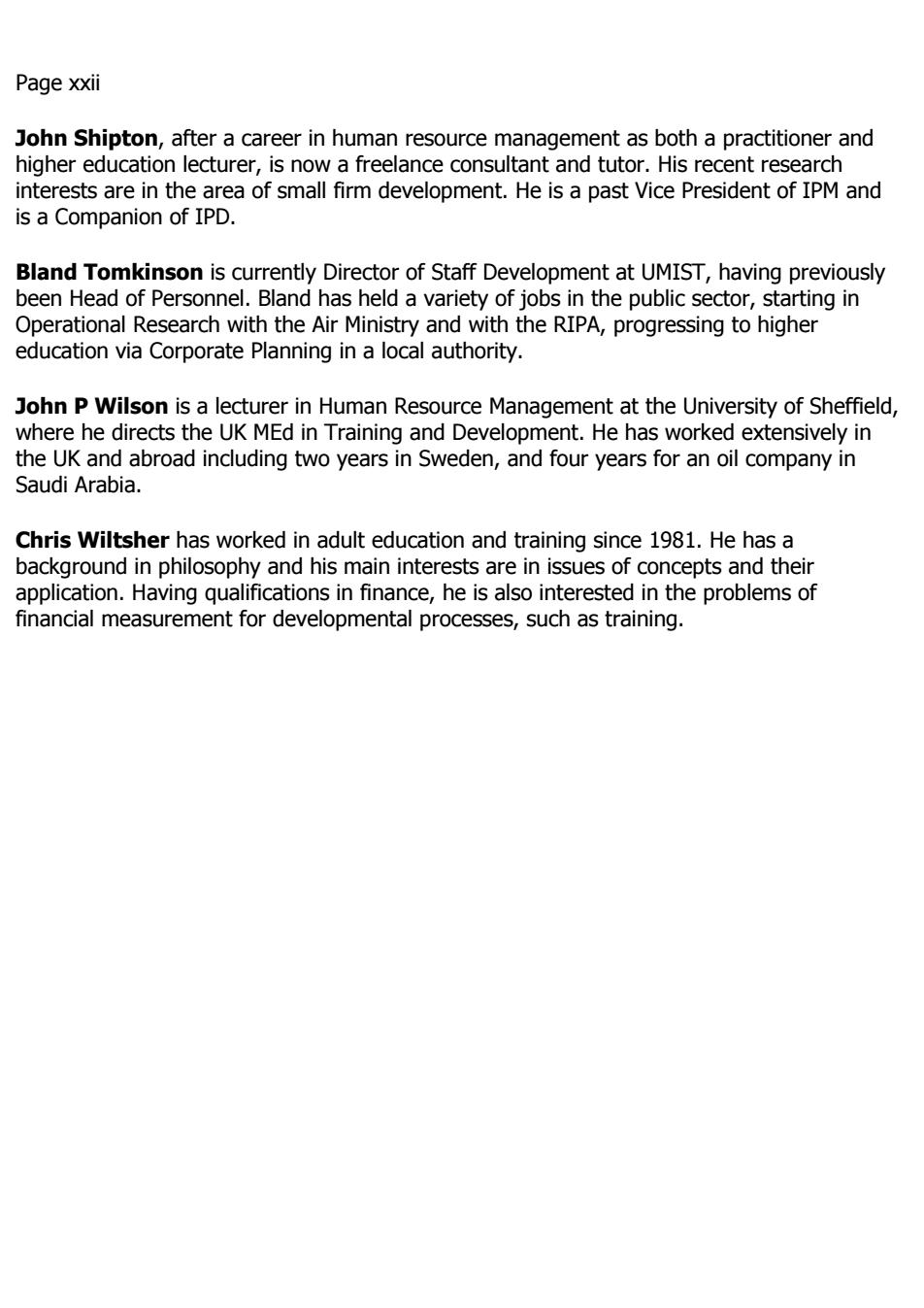
Page xxii John Shipton,after a career in human resource management as both a practitioner and higher education lecturer,is now a freelance consultant and tutor.His recent research interests are in the area of small firm development.He is a past Vice President of IPM and is a Companion of IPD Bland Tomkinson is currently Director of Staff Development at UMIST,having previously been Head of Personnel.Bland has held a variety of jobs in the public sector,starting in Operational Research with the Air Ministry and with the RIPA,progressing to higher education via Corporate Planning in a local authority. John P Wilson is a lecturer in Human Resource Management at the University of Sheffield where he directs the UK MEd in Training and Development.He has worked extensively in the UK and abroad including two years in Sweden,and four years for an oil company in Saudi Arabia. Chris Wiltsher has worked in adult education and training since 1981.He has a background in philosophy and his main interests are in issues of concepts and their application.Having qualifications in finance,he is aso interested in the problems of financial measurement for developmental processes,such as training
Page xxii John Shipton, after a career in human resource management as both a practitioner and higher education lecturer, is now a freelance consultant and tutor. His recent research interests are in the area of small firm development. He is a past Vice President of IPM and is a Companion of IPD. Bland Tomkinson is currently Director of Staff Development at UMIST, having previously been Head of Personnel. Bland has held a variety of jobs in the public sector, starting in Operational Research with the Air Ministry and with the RIPA, progressing to higher education via Corporate Planning in a local authority. John P Wilson is a lecturer in Human Resource Management at the University of Sheffield, where he directs the UK MEd in Training and Development. He has worked extensively in the UK and abroad including two years in Sweden, and four years for an oil company in Saudi Arabia. Chris Wiltsher has worked in adult education and training since 1981. He has a background in philosophy and his main interests are in issues of concepts and their application. Having qualifications in finance, he is also interested in the problems of financial measurement for developmental processes, such as training
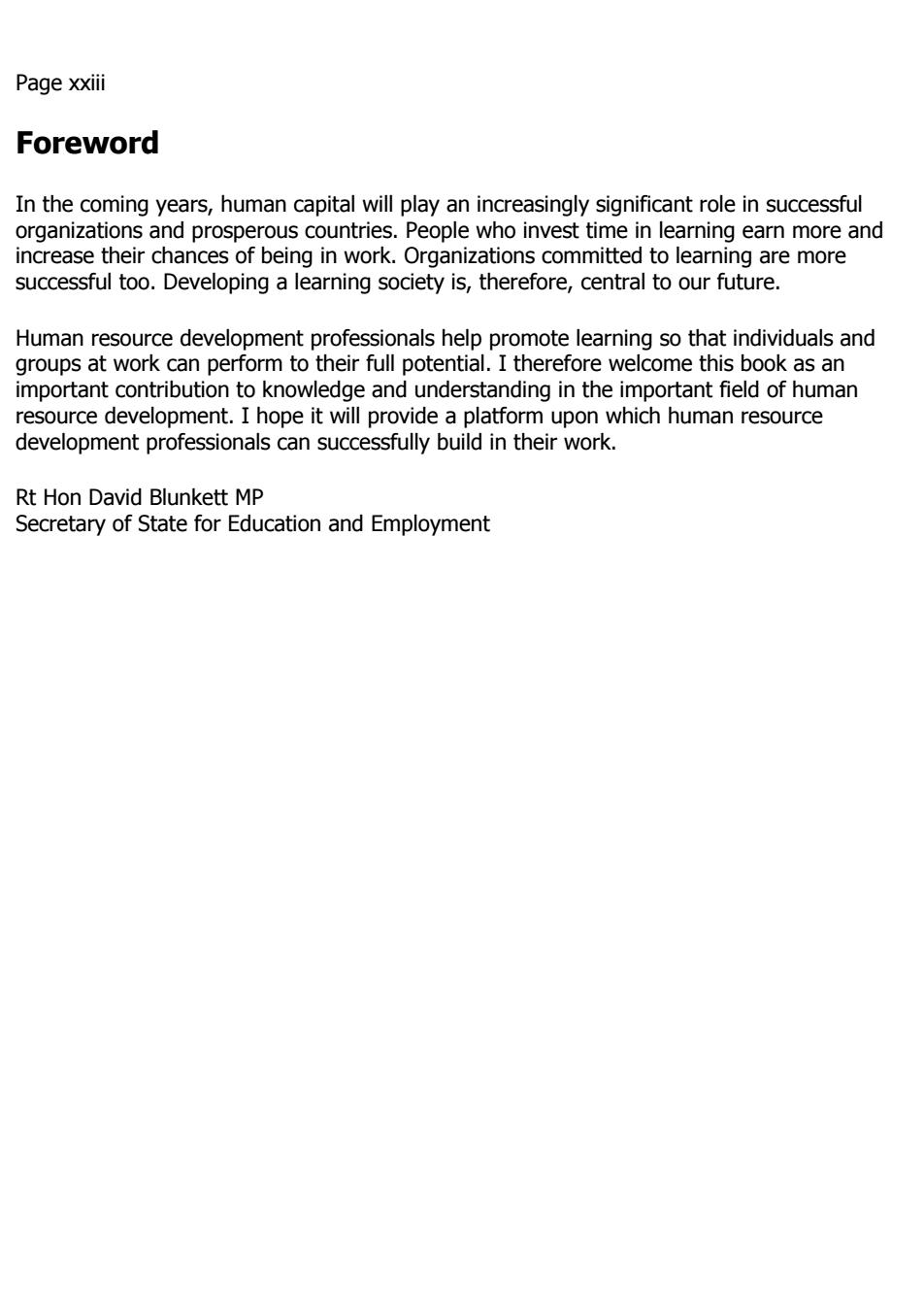
Page xxiii Foreword In the coming years,human capital will play an increasingly significant role in successful organizations and prosperous countries.People who invest time in learning earn more and increase their chances of being in work.Organizations committed to learning are more successful too.Developing a learning society is,therefore,central to our future. Human resource development professionals help promote learning so that individuals and groups at work can perform to their full potential.I therefore welcome this book as an important contribution to knowledge and understanding in the important field of human resource development.I hope it will provide a platform upon which human resource development professionals can successfully build in their work. Rt Hon David Blunkett MP Secretary of State for Education and Employment
Page xxiii Foreword In the coming years, human capital will play an increasingly significant role in successful organizations and prosperous countries. People who invest time in learning earn more and increase their chances of being in work. Organizations committed to learning are more successful too. Developing a learning society is, therefore, central to our future. Human resource development professionals help promote learning so that individuals and groups at work can perform to their full potential. I therefore welcome this book as an important contribution to knowledge and understanding in the important field of human resource development. I hope it will provide a platform upon which human resource development professionals can successfully build in their work. Rt Hon David Blunkett MP Secretary of State for Education and Employment
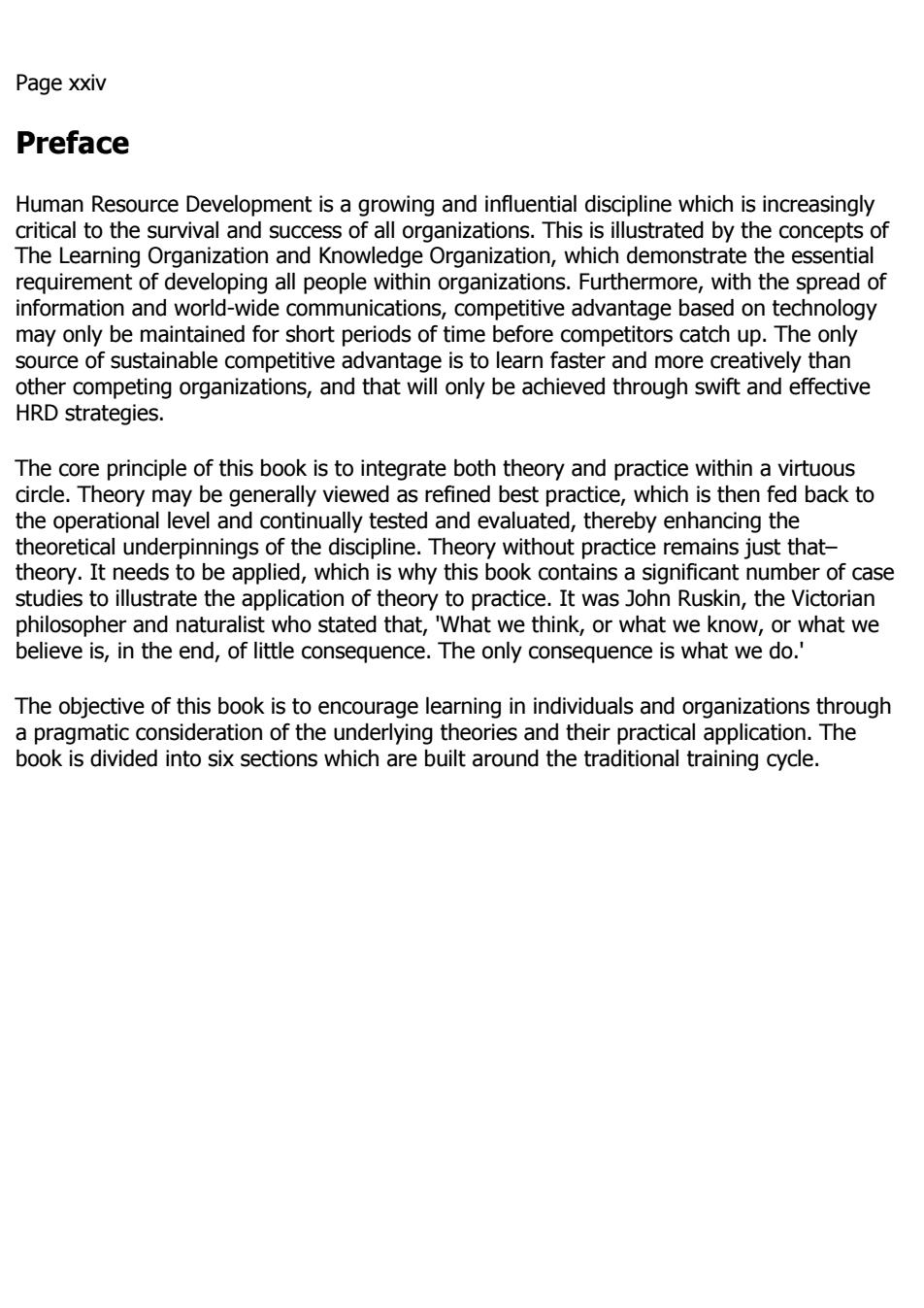
Page xxiv Preface Human Resource Development is a growing and influential discipline which is increasingly critical to the survival and success of all organizations.This is illustrated by the concepts of The Learning Organization and Knowledge Organization,which demonstrate the essential requirement of developing all people within organizations.Furthermore,with the spread of information and world-wide communications,competitive advantage based on technology may only be maintained for short periods of time before competitors catch up.The only source of sustainable competitive advantage is to lean faster and more creatively than other competing organizations,and that will only be achieved through swift and effective HRD strategies. The core principle of this book is to integrate both theory and practice within a virtuous circle.Theory may be generally viewed as refined best practice,which is then fed back to the operational level and continually tested and evaluated,thereby enhancing the theoretical underpinnings of the discipline.Theory without practice remains just that- theory.It needs to be applied,which is why this book contains a significant number of case studies to illustrate the application of theory to practice.It was John Ruskin,the Victorian philosopher and naturalist who stated that,'What we think,or what we know,or what we believe is,in the end,of little consequence.The only consequence is what we do.' The objective of this book is to encourage learning in individuals and organizations through a pragmatic consideration of the underlying theories and their practical application.The book is divided into six sections which are built around the traditional training cycle
Page xxiv Preface Human Resource Development is a growing and influential discipline which is increasingly critical to the survival and success of all organizations. This is illustrated by the concepts of The Learning Organization and Knowledge Organization, which demonstrate the essential requirement of developing all people within organizations. Furthermore, with the spread of information and world-wide communications, competitive advantage based on technology may only be maintained for short periods of time before competitors catch up. The only source of sustainable competitive advantage is to learn faster and more creatively than other competing organizations, and that will only be achieved through swift and effective HRD strategies. The core principle of this book is to integrate both theory and practice within a virtuous circle. Theory may be generally viewed as refined best practice, which is then fed back to the operational level and continually tested and evaluated, thereby enhancing the theoretical underpinnings of the discipline. Theory without practice remains just that– theory. It needs to be applied, which is why this book contains a significant number of case studies to illustrate the application of theory to practice. It was John Ruskin, the Victorian philosopher and naturalist who stated that, 'What we think, or what we know, or what we believe is, in the end, of little consequence. The only consequence is what we do.' The objective of this book is to encourage learning in individuals and organizations through a pragmatic consideration of the underlying theories and their practical application. The book is divided into six sections which are built around the traditional training cycle
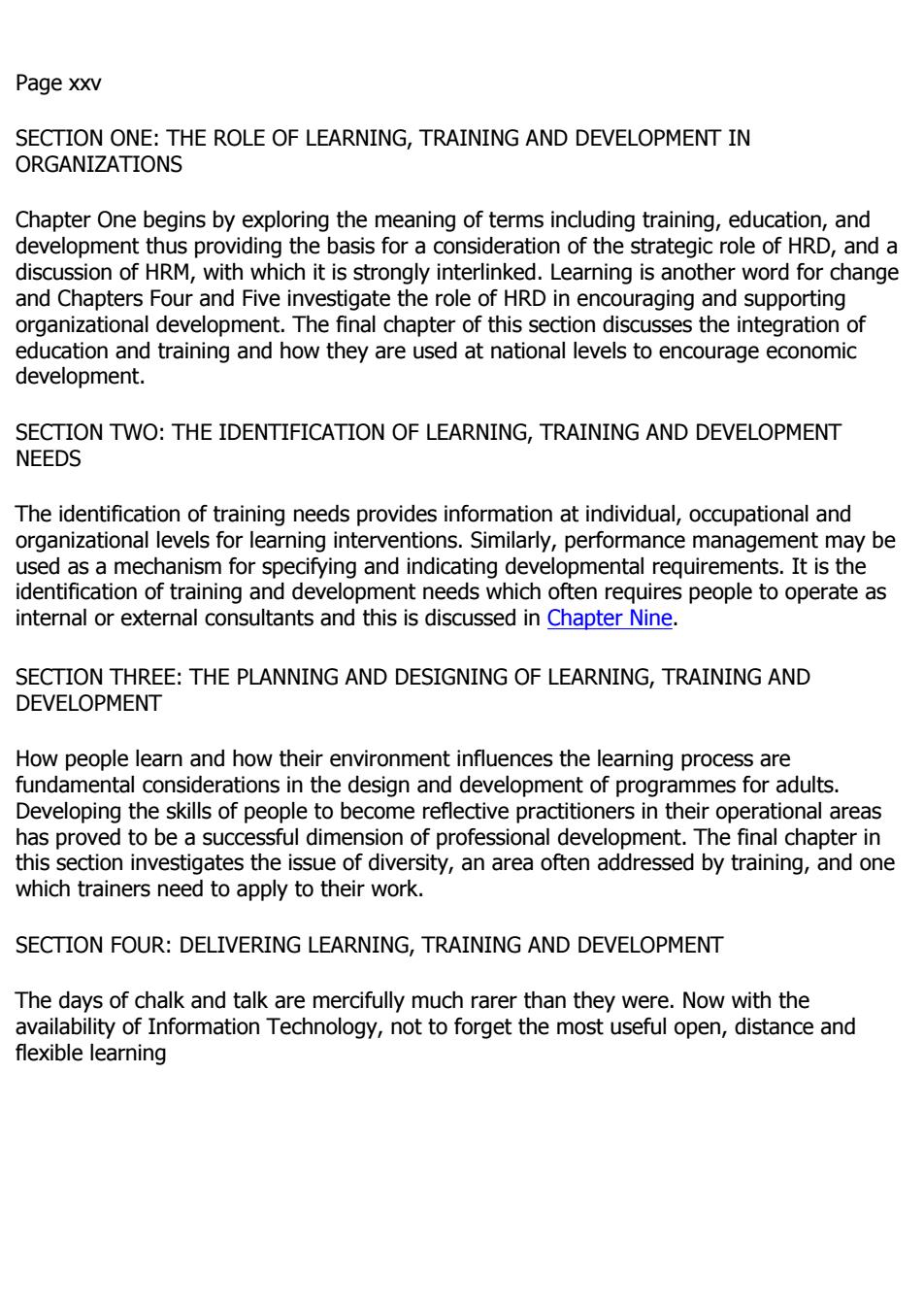
Page xxv SECTION ONE:THE ROLE OF LEARNING,TRAINING AND DEVELOPMENT IN ORGANIZATΠONS Chapter One begins by exploring the meaning of terms including training,education,and development thus providing the basis for a consideration of the strategic role of HRD,and a discussion of HRM,with which it is strongly interlinked.Learning is another word for change and Chapters Four and Five investigate the role of HRD in encouraging and supporting organizational development.The final chapter of this section discusses the integration of education and training and how they are used at national levels to encourage economic development. SECTION TWO:THE IDENTIFICATION OF LEARNING,TRAINING AND DEVELOPMENT NEEDS The identification of training needs provides information at individual,occupational and organizational levels for learning interventions.Similarly,performance management may be used as a mechanism for specifying and indicating developmental requirements.It is the identification of training and development needs which often requires people to operate as internal or external consultants and this is discussed in Chapter Nine. SECTION THREE:THE PLANNING AND DESIGNING OF LEARNING,TRAINING AND DEVELOPMENT How people learn and how their environment influences the learning process are fundamental considerations in the design and development of programmes for adults. Developing the skills of people to become reflective practitioners in their operational areas has proved to be a successful dimnsion of professional develo pment.The final chapter in this section investigates the issue of diversity,an area often addressed by training,and one which trainers need to apply to their work. SECTION FOUR:DELIVERING LEARNING,TRAINING AND DEVELOPMENT The days of chalk and talk are mercifully much rarer than they were.Now with the availability of Information Technology,not to forget the most useful open,distance and flexible learning
Page xxv SECTION ONE: THE ROLE OF LEARNING, TRAINING AND DEVELOPMENT IN ORGANIZATIONS Chapter One begins by exploring the meaning of terms including training, education, and development thus providing the basis for a consideration of the strategic role of HRD, and a discussion of HRM, with which it is strongly interlinked. Learning is another word for change and Chapters Four and Five investigate the role of HRD in encouraging and supporting organizational development. The final chapter of this section discusses the integration of education and training and how they are used at national levels to encourage economic development. SECTION TWO: THE IDENTIFICATION OF LEARNING, TRAINING AND DEVELOPMENT NEEDS The identification of training needs provides information at individual, occupational and organizational levels for learning interventions. Similarly, performance management may be used as a mechanism for specifying and indicating developmental requirements. It is the identification of training and development needs which often requires people to operate as internal or external consultants and this is discussed in Chapter Nine. SECTION THREE: THE PLANNING AND DESIGNING OF LEARNING, TRAINING AND DEVELOPMENT How people learn and how their environment influences the learning process are fundamental considerations in the design and development of programmes for adults. Developing the skills of people to become reflective practitioners in their operational areas has proved to be a successful dimension of professional development. The final chapter in this section investigates the issue of diversity, an area often addressed by training, and one which trainers need to apply to their work. SECTION FOUR: DELIVERING LEARNING, TRAINING AND DEVELOPMENT The days of chalk and talk are mercifully much rarer than they were. Now with the availability of Information Technology, not to forget the most useful open, distance and flexible learning
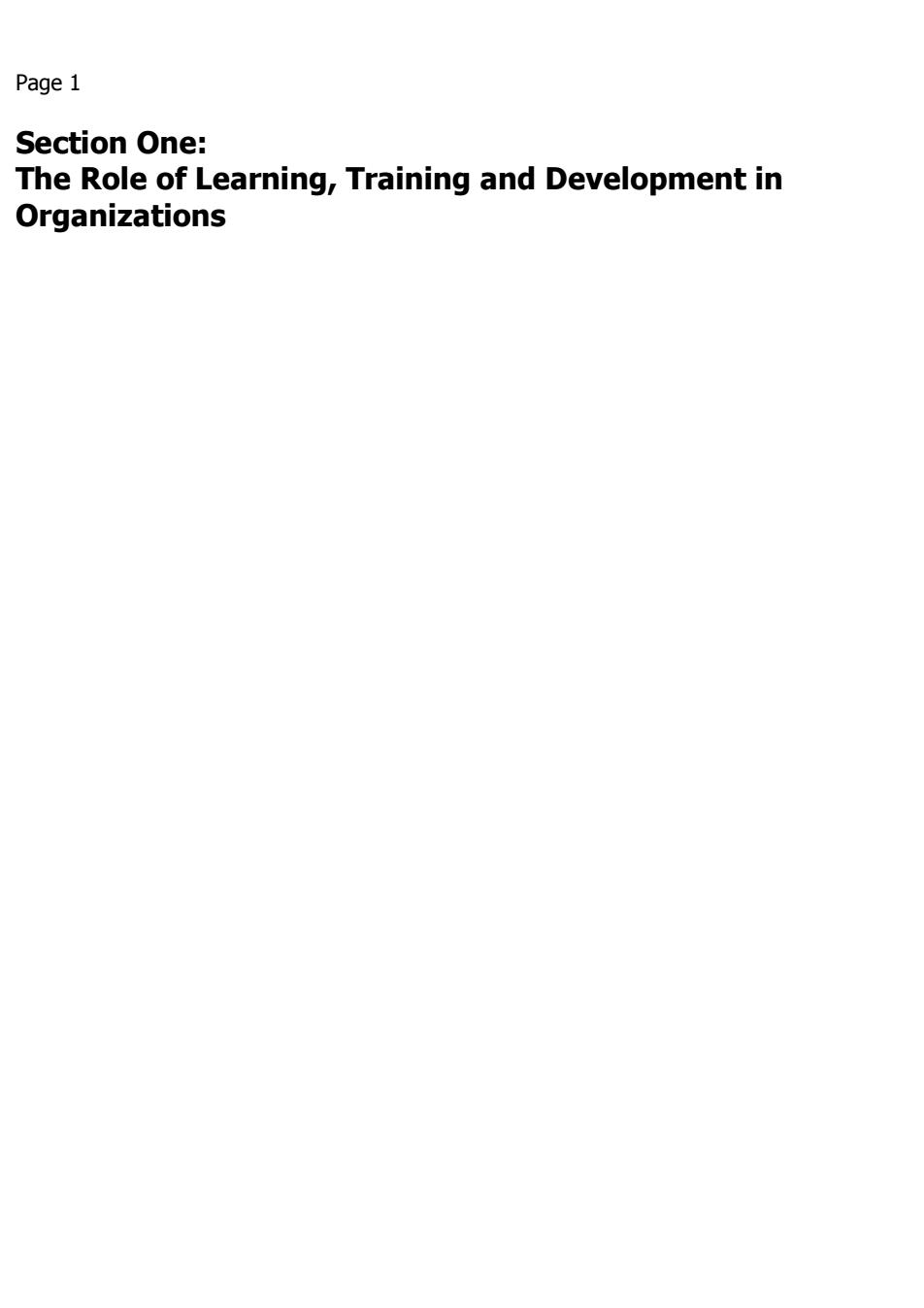
Page 1 Section One: The Role of Learning,Training and Development in Organizations
Page 1 Section One: The Role of Learning, Training and Development in Organizations